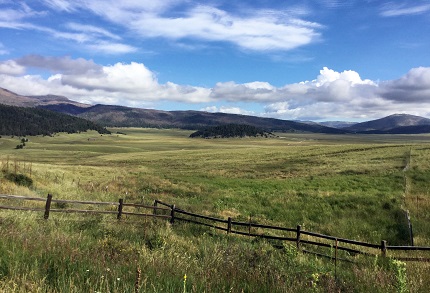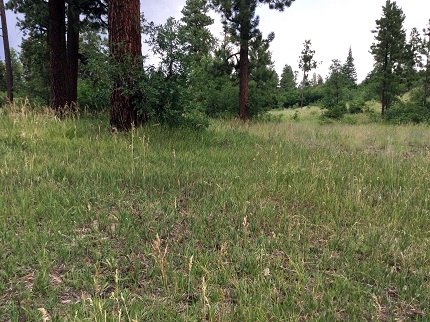 James Cain, a wildlife and affiliate associate professor at New Mexico State University, is part of a team researching wildlife and vegetation responses to forage restoration treatments in the Jemez Mountains in Northern New Mexico. Cain and his research team affix GPS collars to black bears, mule deer and elk to track their movement.
James Cain, a wildlife and affiliate associate professor at New Mexico State University, is part of a team researching wildlife and vegetation responses to forage restoration treatments in the Jemez Mountains in Northern New Mexico. Cain and his research team affix GPS collars to black bears, mule deer and elk to track their movement.
(Photo by Mark Peyton)WRITER: Kristie Garcia, 575-646-4211, kmgarcia@nmsu.edu
CONTACT: James Cain , 575-646-3382, jwcain@nmsu.edu
Among the ponderosa pines in the Valles Caldera National Preserve, large herds of elk may be seen foraging on the grasses along the forest floor.
 As part of the Southwest Jemez Collaborative Landscape Restoration Project, thinning and prescribed burns have taken place on thousands of acres on the Valles Caldera National Preserve in Northern New Mexico. James Cain, a wildlife and affiliate associate professor at New Mexico State University is part of a team researching wildlife and vegetation responses to forage restoration treatments in the Jemez Mountains.
As part of the Southwest Jemez Collaborative Landscape Restoration Project, thinning and prescribed burns have taken place on thousands of acres on the Valles Caldera National Preserve in Northern New Mexico. James Cain, a wildlife and affiliate associate professor at New Mexico State University is part of a team researching wildlife and vegetation responses to forage restoration treatments in the Jemez Mountains.
(NMSU photo by Kristie Garcia) James Cain, a wildlife and affiliate associate professor at New Mexico State University, is part of a team researching wildlife and vegetation responses to forage restoration treatments in the Jemez Mountains in Northern New Mexico. In areas where forest thinning and prescribed burns have occurred, vegetation has begun to grow, which allows for more forage areas for certain mammals. (NMSU photo by Kristie Garcia)Many areas in these Northern New Mexico Jemez Mountains have been through prescribed burns or forest thins to allow for a less dense canopy, so new grasses and shrubs may grow on the forest floor and so wildfires will be less destructive.
James Cain, a wildlife and affiliate associate professor at New Mexico State University, is part of a team researching wildlife and vegetation responses to forage restoration treatments in the Jemez Mountains in Northern New Mexico. In areas where forest thinning and prescribed burns have occurred, vegetation has begun to grow, which allows for more forage areas for certain mammals. (NMSU photo by Kristie Garcia)Many areas in these Northern New Mexico Jemez Mountains have been through prescribed burns or forest thins to allow for a less dense canopy, so new grasses and shrubs may grow on the forest floor and so wildfires will be less destructive.
These forest restoration treatments are part of the larger Southwest Jemez Collaborative Landscape Restoration Project that includes the Santa Fe National Forest and Valles Caldera National Preserve.
James Cain, a wildlife and affiliate associate professor at New Mexico State University, is leading a research team to monitor how certain mammals are responding to the forest thins and prescribed burns.
"My role in this project is to assess the responses of large mammals to these landscape scale forest restoration treatments," Cain said. "We're specifically looking at how the vegetation responds to the thinning and prescribed burns, and then how the herbivores respond to that vegetation. We're looking at the responses of mule deer, elk, black bears and mountain lions."
Wildlife researchers – including Cain – have placed GPS collars on over 50 animals to record their location at regular intervals.
"We usually have 10 to 20 bears, about 50 elk and about 10 or 15 mule deer with GPS collars at any given time," he said. "This allows us to see where they're moving throughout the landscape, which areas they're using and whether they're using the treated areas. If they are using the treated areas, one of the main things we are interested in is how long it takes from when an area is thinned to when it actually becomes an area that's utilized by deer, elk and black bears."
NMSU received a $100,000 research grant from the U.S. Forest Service and National Park Service to help with the larger animal study.
So far, three NMSU wildlife sciences graduate students have worked with Cain on the project. Tanya Roerick, who received a master's degree in the summer, studied mule deer. Sarah Kindschuh and Susan Bard have both researched black bears. Kindschuh received her master's degree in 2015, and Bard is currently pursing her master's degree. Caleb Robers, who received a master's degree in wildlife from Texas Tech University, helped with the project as well, focusing on elk.
Cain, who is the assistant leader of the U.S. Geological Survey's New Mexico Cooperative Fish and Wildlife Research Unit, said the large mammal monitoring part of the project began in 2012. The larger project – the Southwest Jemez Project – was one of 10 Collaborative Forest Landscape Restoration Projects in nine states approved by the U.S. Department of Agriculture in 2010. Congress established the CFLRP in 2009 to encourage collaborative, science-based ecosystem restoration of priority forest landscapes.
The primary reason the Southwest Jemez was a priority was because of the Cerro Grande fire that burned down parts of Los Alamos, New Mexico, in 2000. The fire began in Bandelier National Monument and burned 48,000 acres.
"Because of decades of fire suppression in the Southwestern U.S., many of our ponderosa pine forests and other types of forests have become overgrown, so the canopy is really dense," Cain explained. "And this prevents sunlight from reaching the floor, which results in essentially no forage or vegetation growing underneath the canopy. The forest becomes dominated by many really small-diameter trees. Not only does this have an impact for wildlife that utilize forage on the forest floor, it also results in increased fire danger.
"So when there's a fire, it gets up into that dense canopy and just burns right across the tops of the forest and basically kills all of the trees. Whereas historically, the forest was a little more open. And if there was a lightning strike, the fire would stay on the ground for the most part. And that would be a beneficial fire for wildlife. But now we have less frequent but more severe wildfires."
Hence, the goal of the prescribed burns and thinning of the forest is to open up the canopy to allow the grass to grow for wildlife, and so fires will hopefully be less destructive.
Since the project began, there have also been wildfires that have affected the landscape. The Las Conchas wildfire occurred in 2011, followed by the Thompson Ridge wildfire in 2013. Both fires were incorporated into Cain's research as unplanned treatments.
Research thus far has shown that wildlife responses have varied depending on the type of mammal and whether they are responding to prescribed burns or wildfires.
"So far what we've found is that the elk are really responding to the wildfire burned areas," Cain said. "And those wildfire burned areas have four-to-five times the amount of forage biomass for elk than the untreated areas.
"The mule deer aren't really using the wildfire areas so much, but they are using the prescribed-burn areas, particularly one-to-two years after the prescribed burn."
Cain said the animals' responses to the forest thinned areas have varied as well, depending on what they eat. Mule deer's diet is composed primarily of browse, which includes leaves, shrubs and twigs, and they are not using the thinned areas extensively until at least five years after the thin, when the shrub component returns. Elk's diet is composed primarily of grasses, so they are not using the thinned areas as much.
Other organizations taking part in the collaborative project include the National Park Service, New Mexico Department of Game and Fish, New Mexico Highlands University, Texas Tech University, U.S. Forest Service and U.S. Geological Survey – New Mexico Cooperative Fish and Wildlife Research Unit.
Although Cain and his team are focused on larger mammals, other researchers are responsible for monitoring the responses of fisheries, birds, invertebrates and vegetation in general.
The project is scheduled to run through 2019.


